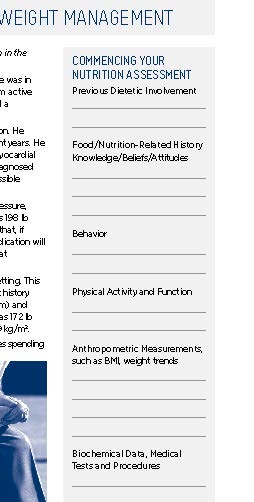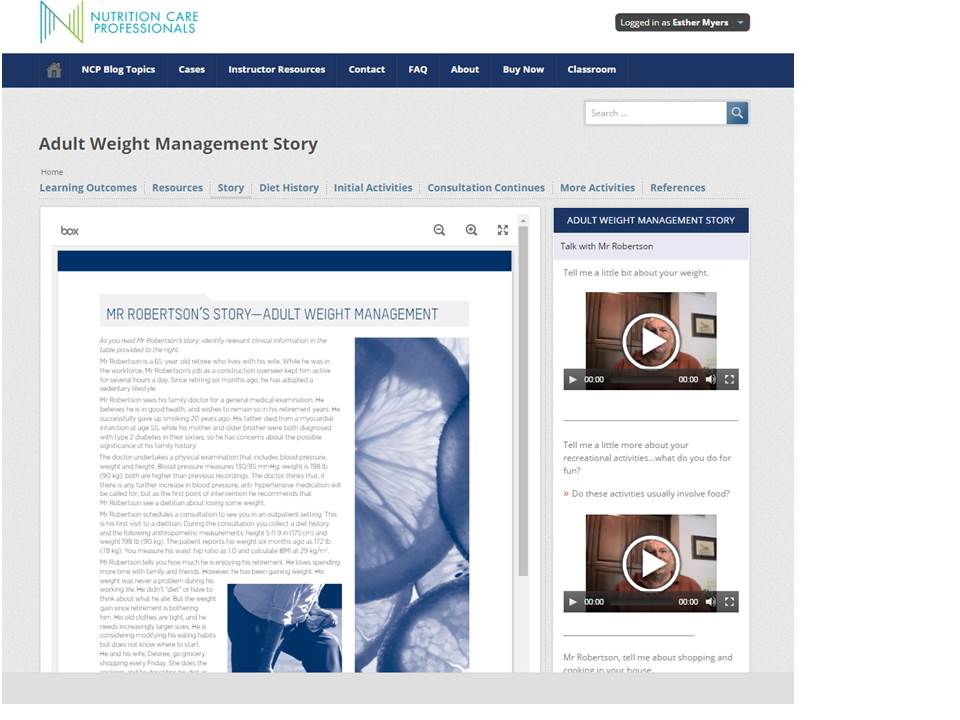
Classes early in the MNT curriculum may only use selected nutrition assessment activities from a case, while more advanced classes may use different cases and different activities from other steps in the nutrition care process. Since Mr. Robertson is used in four progressive cases it allows students to easily progress without repeating all the basic nutrition assessment activities in each case.

For example, in the fall when students were entering into MNT 1, they were assigned the Case 1, Mr. Robertson, Adult Weight Management. During class they were asked to read the "Story" and pull out the significant data and write it in the nutrition assessment categories shown on the page in their text book. This took 30+ minutes as they worked together to process the information provided in the "Story" and Diet History.
The page in the textbook simply listed the main domains of the Nutrition Care Process Terminology for Nutrition Assessment and allowed students to become familiar with the organization of the terminology as well as identify pertinent data from the "story":
- Previous Dietetic Involvement
- Food and Nutrition Related History
- Knowledge/Beliefs/Attitudes
- Behavior
- Physical Activity and Function
- Anthropometric Measures
- Biochemical Data, Medical Tests and Procedures
- Nutrition Focused Physical Findings
- Client History
Student were then asked to go to the website to indepenently complete and turn in the following activities for grading:
 1.1 Apportioning Recipes
1.1 Apportioning Recipes1.2 Nutritional Analysis (using Exchange System)
1.3 Evaluating Food Servings
1.4 Comparing to Dietary Guidelines
However the instructor opted to provide the answers to the next three activities in the text since the students had already learned how to calculate BMI and plot body weights (Activity 1.5), determine energy requirements (Activity 1.6), and estimate impact of physical activity (Activity 1.7).
After those had been discussed, the instructor asked them to each complete and turn in the following activities through the website:
- Activity 1.8, Assessing Knowledge, Beliefs and Attitudes and
- Activity 1.9, Summarizing Nutrition Assessment through the website.
Next the students were assigned to independently work through the Activity 1.10 to identify potential nutrition diagnoses and select the most important ones. The instructor asked the student to formally turn in the Activity 1.11, Developing PES statements .
The PES statements were discussed in the class setting by sharing the PES statements as a group and identifying strengths and weaknesses of the various PES statements developed.
When they moved on to the next cases Hypertension, Type 2 DM and Malnutrition/Oncology, the instructor can easily now just discuss the changes in all the original nutrition assessment data in the class setting and move more quickly into working on other activities such as evaluating progress toward resolving the previous nutrition diagnoses, formulating a new PES statement to reflect Mr. Robertson's current condition and focus on other activities in other steps of the nutrition care process.
For example in the spring when they were enrolled in MNT 2, and were covering Diabetes, the instructor opted to assign Activity:
- 3.6, Estimating carbohydrate distribution and Type (menu/meal planning) ,
- 3.9, Assessing Knowledge, Beliefs and Attitudes and
- 3.11, Evaluating Existing Nutrition Diagnosis.
And in the Oncology/Malnutrition case the following activities were assigned:
- 4.8, Summarizing Nutrition Assessment,
- 4.12, Formulating a Nutrition Prescription and Aims and
- 4.16, Creating a Plan for Monitoring and Evaluating were assigned.
Since the student is familiar with "Mr. Robertson" through the various cases, they are free to focus on the specific activity rather than "learning an whole new case". It also gives them experience with Nutrition Monitoring and Evaluating and seeing how the dietitian develops an ongoing relationship with a patient. The activities leading up the the specific assignments that were to be turned in are still available in the text for students to review if they need to see the steps that they would complete to lead up to the assignments to turn in, but the instructor can select the activities that they want to emphasize and not have them formally complete and turn in activities that they have already mastered or achieved the desired level of competence.
Acknowledgement: Information provided by Jaimette McCulley, Fontbonne University, St Louis, MO
Updated August 17, 2016

